
Process improvement is extremely important, as it leads to the elimination of redundancies and bottlenecks that lead to productivity and deadline issues. It requires a proper identification of business requirements of processes and evaluating the scope of improvement. In a highly competitive business environment, process improvement is crucial for organizations to stay a step ahead.
Business process improvement (BPI) is even more important for organizations that have been continuing their processes for a long time, as it becomes easier to ignore redundancies if they have been going on for a while. Let’s now get into the benefits of process improvement for businesses.
How does Process Improvement help businesses?
Numerous organizations have been able to decrease waste, increase profits, and drive operational efficiency by committing themselves to BPI. They have also been able to utilize their resources better and make the most of their capabilities. By adopting process improvement, businesses have been able to bring about the following benefits:
- In-depth analysis of the existing processes of an organization, which includes checks on efficiency and their scope.
- Identification of avenues of improvement in existing processes that could lead to greater success.
- Alignment of these improvements with business goals.
- Efficient resource allocation and decision-making.
Why is process improvement important?
Process improvement is crucial because it enables organizations to optimize their operations, increase efficiency, reduce waste, enhance customer satisfaction, and stay competitive in a rapidly evolving business environment. It fosters a culture of innovation, empowers employees to contribute to organizational success, and drives sustainable growth and profitability.
Also Read: Data Silos: Breaking down the basics!
How do you Improve A Process?
Now that we have established the importance of business process improvement for organizations, let’s get into the various ways in which it can be implemented.
There are multiple process improvement methodologies that exist, and the final decision needs to be taken basis business goals and the requirement at hand. Some of these options are as follows:
1. Six Sigma Tools
Six Sigma Tools are one of the most popular methods of adopting process improvement. These bunch of tools provides problem-solving support through quantitative and qualitative techniques to drive process improvement. Even though the processes are not unique or distinctive in nature, Six Sigma Tools do have a unique way of integrating and implementing them together. Following are some commonly used Six Sigma processes:
1. DMAIC
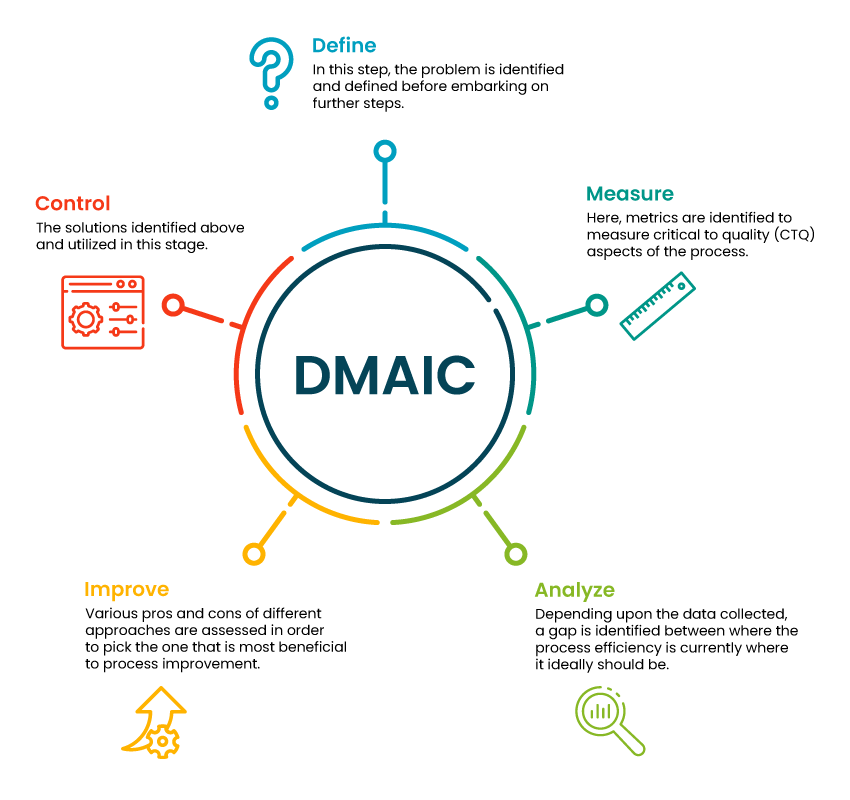
This procedure includes the following principles:
- Define: In this step, the problem is identified and defined before embarking on further steps.
- Measure: Here, metrics are identified to measure critical to quality (CTQ) aspects of the process.
- Analyze: Depending upon the data collected, a gap is identified between where the process efficiency is currently where it ideally should be.
- Improve: Various pros and cons of different approaches are assessed in order to pick the one that is most beneficial to process improvement.
- Control: The solutions identified above and utilized in this stage.
2. DMADV
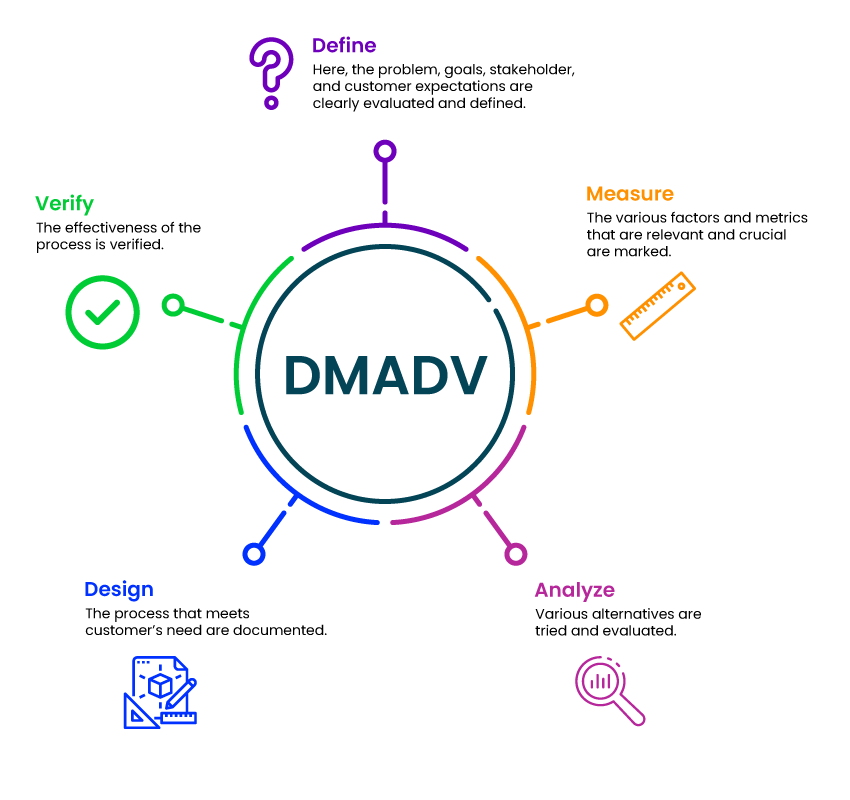
While DMAIC is more focused on improving existing processes, DMADV is more commonly used to create new processes. Here are the various aspects of it:
- Define: Here, the problem, goals, stakeholder, and customer expectations are clearly evaluated and defined.
- Measure: The various factors and metrics that are relevant and crucial are marked.
- Analyze: Various alternatives are tried and evaluated.
- Design: The process that meets customer’s need are documented.
- Verify: The effectiveness of the process is verified.
In addition to the models mentioned, some other Six Sigma tools and techniques are 5S, Seven Wastes, Value Stream mapping, etc. These can be used depending on the needs of the BPI in question.
2. Simulation
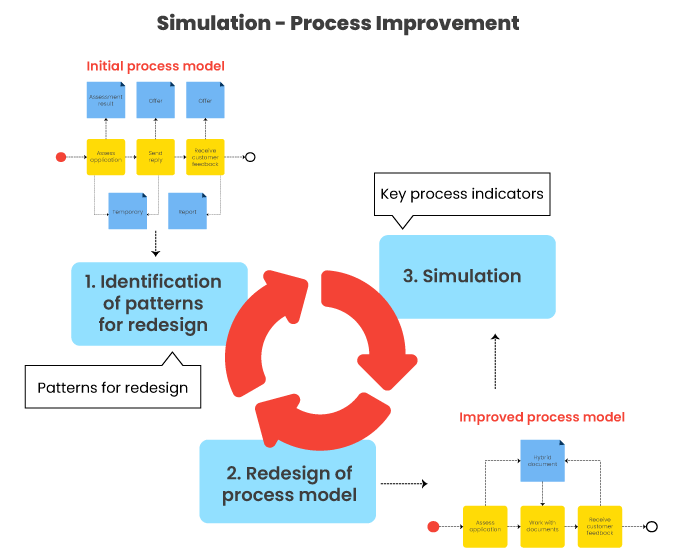
As the name suggests, in this BPI tool a model is created that mimics the operations of various systems. The simulation is time-based and adhered to the various resources and constraints that exist for the actual system as well. Using this, the process can be checked and the scope of process improvement can be tried and verified easily. Insights are gained quickly, which enables managers to take effective decisions. Hence, simulation is a very powerful process improvement tool.

3. Lean manufacturing
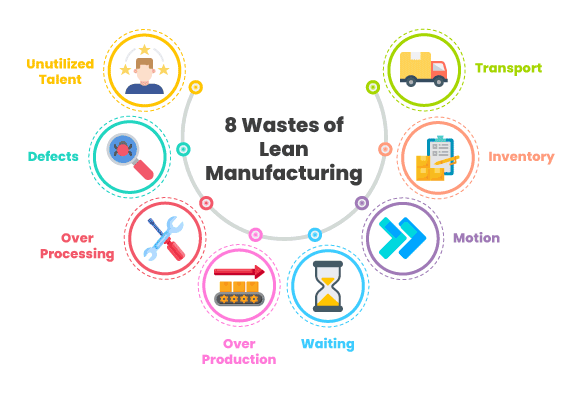
Lean is defined as a method of process improvement where the focus is on reducing and eliminating waste. Even though they are mostly relevant to production environments, lean methods can also be extrapolated to other spheres like healthcare, governments, etc. The primary goal of lean manufacturing is to create a process that decreases wastes significantly, utilizes resources optimally, and ensures continuous improvement. It is a very famous method as it was adopted by Toyota to create near-perfect processes and achieve success.
4. SIPOC analysis
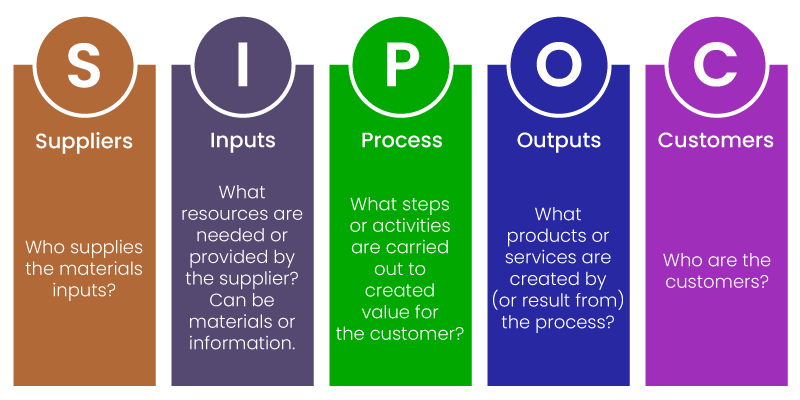
The acronym stands for Suppliers, Inputs, Process, Outputs, and Customer. This tool is primarily used to document business processes across these parameters. Depending upon the goals set for process improvement, these parameters are modified and enhances to gain maximum results. This also ensures full end-to-end visibility over the process.
5. Total quality management
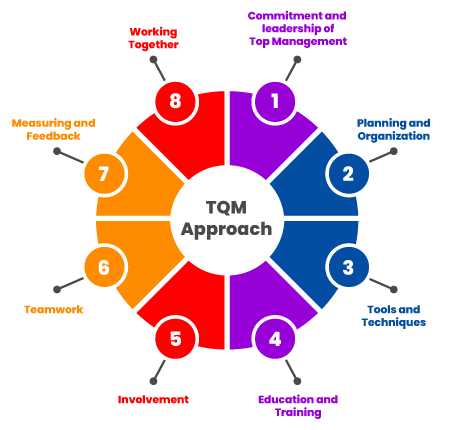
Total Quality Management has guidelines that allow organizations to systematically realize goals and objectives. All employees are encouraged to work towards the same goals and customers verify and validate their efforts in the end. The performance is measured based on this feedback and the loop continues.
In addition to the tools and techniques mentioned above, there exist many ways to bring about process improvement. The idea is to not get caught up in choosing amongst the various tools and techniques. As long as the relevant ones are identified, it is the commitment to continuous process improvement that helps a company succeed in this endeavor.
Also Read: What is Organizational Change Management?
Benefits Of Process Improvement
Increased Efficiency and Productivity
Business process improvement aims to streamline workflows, eliminate unnecessary steps, and reduce bottlenecks. By optimizing processes, organizations can enhance efficiency, enabling tasks to be completed more quickly and with fewer resources. This efficiency boost often leads to increased productivity among employees, allowing them to focus on value-added activities and strategic initiatives.
Cost Savings
Improving business processes often results in cost reductions. By identifying and eliminating waste, redundancies, or inefficiencies, organizations can lower operational expenses. Streamlining processes can lead to reduced cycle times, decreased errors, better resource utilization, and minimized rework, all contributing to significant cost savings over time.
Enhanced Quality and Customer Satisfaction
Process improvement initiatives aim to enhance the quality of products or services by ensuring consistency, accuracy, and reliability. When processes are optimized, there’s a reduction in errors, defects, and deviations, resulting in higher-quality outputs. Improved quality often leads to increased customer satisfaction as customers receive better products or services delivered in a timely and reliable manner, ultimately fostering stronger relationships and loyalty.
These benefits underscore the importance of continuously assessing and refining business processes, as they directly contribute to organizational success, competitiveness, and customer satisfaction.
Maximizing Process Improvement through Automation
Improving business process improvement strategies through automation involves leveraging technology to streamline and optimize workflows. Here’s how you can enhance BPI strategies using automation:
- Identify Processes for Automation: Assess your existing business processes and identify tasks or workflows that can benefit from automation. Look for repetitive, rule-based, or time-consuming activities suitable for automation.
- Set Clear Objectives: Define specific goals and outcomes you aim to achieve through automation. Whether it’s reducing processing time, minimizing errors, or enhancing scalability, having clear objectives will guide your automation efforts.
- Select the Right Automation Tools: Choose automation tools or software that align with the identified processes. Workflow automation platforms, robotic process automation (RPA), AI-powered systems, or task-specific tools can streamline operations effectively.
- Map Processes and Optimize: Create a detailed map of the processes targeted for automation. Identify areas where automation can be integrated seamlessly without disrupting the workflow. Streamline processes before automation to avoid automating inefficient processes.
- Implement Incrementally: Start with small-scale automation initiatives to test and refine the automation strategy. Gradually expand automation to more complex processes once the initial implementations prove successful.
- Training and Change Management: Train employees on using automation tools and communicate the benefits of automation to gain their support. Address any concerns about job displacement and emphasize how automation can augment their roles by freeing up time for more strategic tasks.
- Continuous Monitoring and Improvement: Regularly monitor automated processes to ensure they’re performing as intended. Analyze data and feedback to identify areas for further optimization or refinement in the automated workflows.
- Integration and Scalability: Integrate automation tools with existing systems and ensure scalability. As your business grows or processes evolve, ensure that the automated solutions can adapt and scale accordingly.
- Data Security and Compliance: Implement robust security measures to protect sensitive data handled through automated processes. Ensure that automated workflows comply with industry regulations and data privacy standards.
- Feedback and Iteration: Encourage feedback from stakeholders and users of automated processes. Use this feedback to iterate and improve upon the automated workflows continuously.
By strategically incorporating automation into business process improvement strategies, organizations can streamline operations, reduce errors, enhance efficiency, and empower employees to focus on higher-value tasks, ultimately driving greater productivity and success.
Also Read: Mastering Digital Organization: A Guide to Thriving in a Tech-Driven World
Supercharge your process improvement journey with “No-Code”
In the quest for process improvement, traditional barriers of coding expertise and development cycles can hinder progress. But fear not, for the era of no-code platforms has arrived to revolutionize the game! With these empowering tools, you can take charge of your process improvement journey like never before.
No-code platforms empower individuals across your organization, regardless of technical background, to become agents of change. By providing intuitive interfaces, drag-and-drop functionality, and pre-built components, they unlock the ability to create customized applications and automate workflows with ease. Rapid iterations, quick experiments, and seamless customization become the norm, accelerating your process improvement efforts.
Say goodbye to relying solely on developers or waiting for lengthy development cycles. No-code platforms put the power in your hands, allowing you to make real-time adjustments, optimize workflows, and drive continuous improvement. Embrace the creativity, innovation, and agility that come with a no-code approach, and witness how it transforms your organization’s ability to adapt, innovate, and thrive in the ever-evolving business landscape.
Embrace the power of no-code, and embark on a process improvement journey that unleashes your team’s potential, fuels innovation, and propels your organization to new heights. The time to supercharge your process improvement efforts is now!
Also read: Business Process Reengineering: Is it the perfect solution for your problems?
Takeaway
For organizations to succeed in today’s fiercely competitive world, the only way is to never become complacent about their processes and assume that they have got it right. A continuous and agile outlook towards process improvement can go a long way in helping an organization in standing out. Business processes also need to be automated in order to succeed, as the world around us is shifting rapidly away from manual processes. Business Process Automation eliminates all the inefficiencies and redundancies involved in manual processes and allows organizations to save up on precious resources and time while ensuring higher profitability.
Quixy is an award-winning no-code platform that has empowered numerous organizations to undergo Business Process Automation without writing a single line of code. With our easy-to-use visual platform, automation can be done without any of the hassles that are associated with traditional coding. Our clients are a testament to the digital transformation that Quixy can bring about in your organization.
Ready to transform your business? Get started now and experience the power of automation and app creation, all without the need for coding skills.
Frequently Asked Questions (FAQs)
Q. What is process improvement?
Process improvement refers to the systematic approach of identifying, analyzing, and implementing changes to enhance efficiency, productivity, and quality within organizational processes. It involves evaluating current processes, identifying areas for improvement, and implementing strategies to optimize workflows and achieve better outcomes.
Q. What is continuous improvement process?
Continuous process improvement is an ongoing, iterative approach to improving processes within an organization. It emphasizes the pursuit of incremental enhancements over time rather than isolated efforts. It involves constantly evaluating processes, gathering feedback, making adjustments, and striving for continuous growth and improvement to achieve higher levels of performance and competitiveness.
Q. What are some common challenges faced during process improvement initiatives?
While implementing process improvement, organizations may face challenges such as resistance to change, lack of employee engagement, inadequate resources or expertise, difficulty in measuring success, and ensuring sustained improvements over time.
Q. How can technology and automation support process improvement efforts?
Technology and automation, including no-code platforms, are crucial in supporting process improvement efforts. By leveraging these tools, organizations can streamline operations, optimize efficiency, and drive meaningful change. No-code platforms empower non-technical users to develop custom applications and automate workflows without coding knowledge, eliminating the need for traditional software development cycles. This enables rapid prototyping, quick iterations, and seamless customization of processes. Automation through technology simplifies repetitive tasks, reduces human error, and enhances overall productivity. Additionally, data analytics and reporting tools integrated into technology solutions provide valuable insights for identifying bottlenecks, optimizing resource allocation, and making data-driven decisions to improve processes continually.
Q. How to identify process improvement opportunities?
To identify process improvement opportunities, organizations can involve employees in brainstorming sessions, conduct process audits or assessments, analyze customer feedback, review performance metrics, and benchmark against industry best practices. Encouraging a culture of continuous improvement and open communication can also help uncover areas where processes can be streamlined, bottlenecks can be eliminated, and efficiency can be enhanced.
Subscribe
Login
Please login to comment
0 Comments
Oldest
















